Over the past couple of years, I’ve taken some of what I consider to be “personal projects”. The assignments I give myself aren’t difficult; they may have been to focus on a particular area to show it in a unique way, or to learn new techniques, or to push myself out of my box a little bit. Many of the projects are ongoing, but I find they are a great way for me to inspire my own creativity. So it was with my winter project; I wanted to take on a project that pushed me outside of my box.
As a group, one of my favorite plants are Agave. They have beautifully symmetric, radiating leaves. Their lines are smooth, easy, even sensuous, and their colors are–to me–calming. They come in many shapes and sizes. And, of course, they are the source of tequila (doesn’t a margarita sound good right now?).
Despite my admiration for these plants, until this winter I had only given a half-hearted attempt to photograph them. Because we were lucky to have many overcast days this winter with soft, diffuse light, I decided to take on the project of creating a set of intimate portraits of Agave. To make the set more “uniform” I chose to convert each image to monochrome, and although you’ll see uniformity may be left up to the viewer, I did stick with that as my theme.
In addition to getting to know a new group of plants, I was able to learn about black and white conversions, as well as receive some lessons in extending my depth of field. To achieve the highest resolution, I wanted to stay at an aperture of about f/8, but shooting this close with my 24-105/4, there was no way the entire plant would be in focus. What I did was take multiple frames of each image, each one at a different plane of focus. I then used the auto-align and auto-merge features in Photoshop CS4 to produce a single image with extended depth of field; I hope to write blog post on this procedure in the future.
I’ll share one or more of my Agave shots in the next few days; if you simply cannot wait, you can see them all (so far) here. Its good to remember that by taking on a personal project, you can often find inspiration very near to (if not in) your own backyard. Have you taken on a personal project? Share it in the comments section!
Enjoy…



Lot of neat characteristics brought out in these. They have an IR quality to them almost. Neat plant too, including the very healthy and tasty Agave Nectar.
Fantastic study of lines and curves!I highly recommend readers take a look at the whole series.
Both of these are beautiful. Your second image is particularly interesting because of the abstraction and unique qualities. You bring out the shapes and patterns on the leaves in black and white. As you may know, my father was one of the first to widely publish photographs of Agave plants up close. There are also some new ones he did later in life that have yet to be released. Many people talk about how difficult it was to make good photographs with a view camera, but in some respects, the process you describe is possibly more complex and difficult to get right. It might be easier to make a photograph of an Agave with a view camera…?
Thanks for all the comments!
David, I appreciate your evaluation of the images, because I wanted the images to be somewhat abstract, but still recognizable. There was quite a bit of visualization in my mind’s eye going on in the weeks leading up to these photos, as well as trial and error in the technique. While technology can really free us from the technological limitations of our equipment, it also can introduce a whole new set of challenges. An interesting paradox.